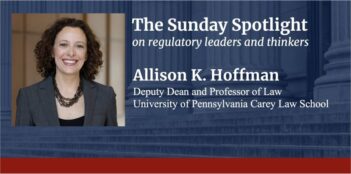
Several U.S. Supreme Court cases from this past term have significant implications for the provision of medical care.
I used to tell health law students that we would read few Supreme Court cases in a class largely comprising common law and state regulation. That statement rings less and less true over time.
Health care spending nears 20 percent of the economy, and health care matters constituted a large share of the U.S. Supreme Court’s docket in the 2021-2022 term. This essay describes a selection of those cases to illustrate how health care prompted litigation and opinions that ranged from inconsequential to transformative. I start by reviewing the cases from this past term having the lowest impact on the U.S. health care system and proceed toward those with the highest impact.
Low-Impact Cases. This session included several cases concerning Medicare, the federal health care program for older people and people with disabilities. Two cases that I followed closely, American Hospital Association (AHA) v. Becerra and Becerra v. Empire Health Foundation, dealt with agency interpretation of Medicare payment rules. Either could have had a significant legal impact, but neither did. Both illustrate the complexity of what the Court faces on health care matters.
AHA v. Becerra was a challenge to a Department of Health and Human Services (HHS) rule about Medicare drug reimbursement to hospitals. Under a program known as 340B, manufacturers provide discounts on drugs to hospitals that disproportionately serve vulnerable populations. These 340B hospitals can bill insurers, including Medicare, full price and use the difference between full price and the discounts to subsidize other services. In a 2017 rule, HHS decreased drug reimbursement to 340B hospitals because of their receipt of discounted drugs.
The litigants in this case questioned whether this policy was consistent with the Medicare statute, which says HHS may pay based on hospitals’ acquisition cost, if HHS collects survey data on those costs, or, if not, based on average sale prices.
Justice Brett Kavanaugh’s opinion for a unanimous court provided a simple reading of the statute. “Under the text and structure of the statute,” he wrote, “this case is therefore straightforward: Because HHS did not conduct a survey of hospitals’ acquisition costs, HHS acted unlawfully by reducing the reimbursement rates for 340B hospitals.”
Even though HHS must now pay 340B hospitals higher rates for the years at issue, the agency now collects survey data that will likely justify lower rates going forward.
In the second Medicare case, Empire Health Foundation, the Court considered another payment policy called the “disproportionate share hospital” adjustment, or DSH. Hospitals that treat a large share of low-income Medicare and Medicaid patients get extra federal funding. In describing how to calculate this share, the statute refers to patients “entitled to” Medicare and “eligible for” Medicaid. This case challenged as inconsistent with the statute a 2006 HHS rule that redefined what it meant to be “entitled to” Medicare.
After poking fun at the complexity of the issue, Justice Elena Kagan wrote the majority opinion—joined by Justices Clarence Thomas, Sonia Sotomayor, Amy Coney Barrett, and Kavanaugh—that held that the HHS rule was consistent with the language in context with the Medicare statute.
These cases might have been opportunities for the Court to make a more significant mark on administrative deference or statutory interpretation doctrine. Instead, in both cases, the Court’s opinions were straightforward interpretations of the statute.
Higher-Impact Cases. Several other cases, however, will have more lasting impact on legal doctrine and, in turn, on people’s lives.
The first deals with whether someone who is wrongfully injured can retain tort recoveries for health care spending. In Gallardo v. Marstiller, the Court held that the Medicaid Act permits states to seek reimbursement from tort settlements for money that state Medicaid programs spend on care—both past and future spending. This recoupment is contentious because it often leaves injured plaintiffs undercompensated for harms, as it did in this case where a 13-year-old was hit by a truck when stepping off her school bus and was left with a permanent and severe disability. The family sought $20 million in damages and received an $800,000 settlement, of which Florida claimed $300,000, leaving the family to shoulder a large share of the costs of care.
In addition to Gallardo, in January the Supreme Court decided two “shadow docket” cases concerning Biden Administration vaccination mandates. In NFIB v. Department of Labor, the Court halted a rule issued by the Occupational Safety and Health Administration (OSHA) that required all employers with over 100 employees to create a worker vaccination policy or require workers to test weekly and wear masks. In Biden v. Missouri, however, the Court on the same day allowed a mandate by the Centers for Medicare and Medicaid Services (CMS) to proceed that required health care facilities receiving federal health care funding to ensure that staff are vaccinated against COVID-19, unless exempted for medical or religious reasons.
The Court determined that OSHA had exceeded its authority to promote workplace safety under the Occupational Health and Safety Act, whereas CMS acted within its authority conferred by Congress to set conditions for participation in federal health care programs. The Biden opinion described the CMS rule as justified to protect patients and consistent with past regulatory practices.
Although the OSHA decision likely slowed vaccine uptake, its greatest impact stems from how it will constrain future regulatory authority in unprecedented public health emergencies. Foreshadowing the announcement of the major questions doctrine, as discussed below, the Court called OSHA’s rule a “significant encroachment into the lives—and health—of a vast number of employees.”
Highest-Impact Cases. For many people, Dobbs v. Jackson Women’s Health Organizations was the most notable opinion of the Court’s term, as it overturned abortion rights first announced in 1973 in Roe v. Wade. Another essay in this series discusses Dobbs’s broader impact for constitutional law. The decision has also created a cascade of health care regulatory questions that lawyers and courts will need to address: What reproductive health care information does HIPAA protect? Can employer health plans provide employees with abortion access? Can women get access to medical abortions from out of state?
Even with Dobbs, what may be the most monumental health care case this session is West Virginia v. Environmental Protection Agency, a case about clean air regulation that appears to have little to do with health care on the surface. In his 6-3 majority opinion, Chief Justice John Roberts explicitly announced for the first time that the “major questions doctrine” requires that, in “extraordinary cases” of “economic and political significance,” an agency must show “clear congressional authorization.” In justifying this doctrine, Roberts recharacterized a series of cases as major questions precedents, including the NFIB v. Department of Labor decision discussed above.
HHS, which includes the Food and Drug Administration, Centers for Disease Control and Prevention, CMS, and more, is one of the most important agencies that regularly deals with politically and economically significant matters. The West Virginia decision will impede HHS from regulating nimbly in novel, evolving, and often critical circumstances, including possible federal abortion regulations post-Dobbs and future efforts to manage public health emergencies similar to COVID-19.
Summary. Health care is at the center of political contests, moral battles, and, increasingly, important Supreme Court decisions. This small and cursory sampling of the 2021-2022 cases illuminates how the Roberts’ Court is fundamentally shaping the future of health care law and policy—and, equally, how health care laws serve as fodder for fundamental shifts in legal doctrine.
This essay is part of a ten-part series entitled The Supreme Court’s 2021-2022 Regulatory Term.




